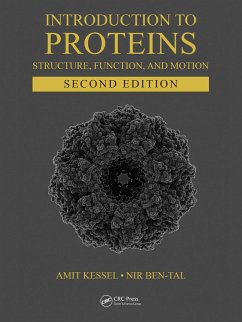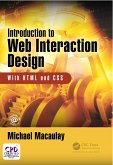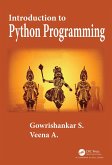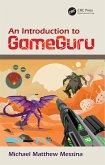Introduction to Proteins shows how proteins can be analyzed in multiple ways. It refers to the roles of proteins and enzymes in diverse contexts and everyday applications, including medical disorders, drugs, toxins, chemical warfare, and animal behavior. This edition includes a brand-new chapter on enzymatic catalysis and biochemistry, an in-depth discussion of G-protein-coupled receptors (GPCRs), and a wider-scale description of methods for studying proteins.
Dieser Download kann aus rechtlichen Gründen nur mit Rechnungsadresse in A, B, BG, CY, CZ, D, DK, EW, E, FIN, F, GR, HR, H, IRL, I, LT, L, LR, M, NL, PL, P, R, S, SLO, SK ausgeliefert werden.
"This is the most interesting to read and complete text I have found for senior undergraduate or early graduate-level coverage of protein structure and function, and a great reference book to have on hand. This text is significantly updated and printed in a hardcover format with easy-to-read text (larger font and pages than usual, with margins for note-taking) and comes with annotatable ebook access for free. Overall, this is a significantly enriched 2nd edition of a book we have used successfully for several years now, which I enthusiastically recommend!" --Leslie Kuhn, Departments of Biochemistry & Molecular Biology and Computer Science & Engineering, Michigan State University, USA
"I used this book when studying for a course on the Mechanisms of Enzyme Catalysis. The book made everything I was struggling with so clear! It is extremely well organized and very, very thorough which makes studying from it easy! 10/10 would recommend to anyone studying proteins and/or enzymes, or even someone who just wants to learn more. Anyone looking for a supplementary reading for your course should have this text book - even if you think you don't need it, trust me, you do." --Customer review on Amazon.com
Praise for the First edition:
"This book offers a unique combination of structure, thermodynamics and biology. I was impressed both by the breadth of the topics covered and by the depth in which they are treated. General principles are made intuitively clear based on well-chosen examples, many of them having relevance to disease. The book could fit well as a textbook in structural biology and molecular biophysics courses." --Barry Honig, Columbia University, New York, New York, USA
"I've just lately used this textbook for a presentation on electrostatics. Although I have an organic background, I discovered that the explanations of electrostatic interactions are very clear and informative. The language isn't too technical and may be easily understood by biology students. The textbook covers numerous examples and colorful illustrations, which made it easy to understand the principles discussed. The book is well organized in chapters for all the fundamental topics. I feel this book would be appropriate for any undergraduate and graduate scholar who's keen on proteins. ... It's complete, easy to observe and (something I at least discover uncommon for textbooks) pleasing to read. The authors don't shrink back from any subjects, but clarify things in a straightforward method supported by ample examples. Highly recommended." --Physics Book Reviews at dowdawgs.com, May 2013
"Introduction to Proteins is an excellent, state-of-the-art choice for students, faculty, or researchers needing a monograph on protein structure. ...The book is clear, well organized, aptly illustrated in color, and a pleasure to read. The first two chapters are an impressive textbook unto themselves ... The book is thoroughly documented with citations to the literature gathered at the end of each chapter. ... Overall, this is an immensely informative, thoroughly researched, up-to-date text, with broad coverage and remarkable depth. Introduction to Proteins would provide an excellent basis for an upper level or graduate course on protein structure, and a valuable addition to the libraries of professionals interested in this centrally important field." --Eric Martz, Biochemistry and Molecular Biology Education, Vol. 40, 2012
"This is an important book. It captures in a very accessible way a growing body of literature on the structure, function and motion of proteins, and links this to more established paradigms such as a reader might find in a mainstream biochemistry text. The text is littered with excellent examples of the wider relevance of the material covered. The book is also exceptionally well written. I learned new things from each chapter. Overall, a superb publication that would be very useful to undergraduates, graduate students, postdoctoral researchers and instructors involved in structural biology or biophysics courses or in research on protein structure-function relationships. I would recommend it highly." --David Sheehan, ChemBioChem, 2011
"The book provides general guidelines for understanding protein structure and demonstrates how we can use the structure to phrase testable hypotheses about biological function. The repeated use of the same example makes it easier for the reader to grasp the general principles. The book gives a coherent picture of each topic and includes ample references, making it possible for the interested reader to dig deeply into various topics. The book also covers structural aspects of intrinsically unstructured proteins and how this property facilitates their biological function. It provides background in cell biology, basic chemistry and thermodynamics, making it useful for newcomers to the protein structure field who want to catch up quickly. It is also easy for experts to dive into the more specialized aspects quickly. The book provides references to user-friendly web tools in the field. The publisher's website provides exercises on both theory and practice. Sample solutions and PowerPoint presentations are available for qualified teachers. These make the book attractive as the main textbook in an undergraduate course on protein structure, for parts of freshman biochemistry, and as a supplement for many undergraduate and graduate courses." --Burkhard Rost, Technische Universität München, Germany
"I used this book when studying for a course on the Mechanisms of Enzyme Catalysis. The book made everything I was struggling with so clear! It is extremely well organized and very, very thorough which makes studying from it easy! 10/10 would recommend to anyone studying proteins and/or enzymes, or even someone who just wants to learn more. Anyone looking for a supplementary reading for your course should have this text book - even if you think you don't need it, trust me, you do." --Customer review on Amazon.com
Praise for the First edition:
"This book offers a unique combination of structure, thermodynamics and biology. I was impressed both by the breadth of the topics covered and by the depth in which they are treated. General principles are made intuitively clear based on well-chosen examples, many of them having relevance to disease. The book could fit well as a textbook in structural biology and molecular biophysics courses." --Barry Honig, Columbia University, New York, New York, USA
"I've just lately used this textbook for a presentation on electrostatics. Although I have an organic background, I discovered that the explanations of electrostatic interactions are very clear and informative. The language isn't too technical and may be easily understood by biology students. The textbook covers numerous examples and colorful illustrations, which made it easy to understand the principles discussed. The book is well organized in chapters for all the fundamental topics. I feel this book would be appropriate for any undergraduate and graduate scholar who's keen on proteins. ... It's complete, easy to observe and (something I at least discover uncommon for textbooks) pleasing to read. The authors don't shrink back from any subjects, but clarify things in a straightforward method supported by ample examples. Highly recommended." --Physics Book Reviews at dowdawgs.com, May 2013
"Introduction to Proteins is an excellent, state-of-the-art choice for students, faculty, or researchers needing a monograph on protein structure. ...The book is clear, well organized, aptly illustrated in color, and a pleasure to read. The first two chapters are an impressive textbook unto themselves ... The book is thoroughly documented with citations to the literature gathered at the end of each chapter. ... Overall, this is an immensely informative, thoroughly researched, up-to-date text, with broad coverage and remarkable depth. Introduction to Proteins would provide an excellent basis for an upper level or graduate course on protein structure, and a valuable addition to the libraries of professionals interested in this centrally important field." --Eric Martz, Biochemistry and Molecular Biology Education, Vol. 40, 2012
"This is an important book. It captures in a very accessible way a growing body of literature on the structure, function and motion of proteins, and links this to more established paradigms such as a reader might find in a mainstream biochemistry text. The text is littered with excellent examples of the wider relevance of the material covered. The book is also exceptionally well written. I learned new things from each chapter. Overall, a superb publication that would be very useful to undergraduates, graduate students, postdoctoral researchers and instructors involved in structural biology or biophysics courses or in research on protein structure-function relationships. I would recommend it highly." --David Sheehan, ChemBioChem, 2011
"The book provides general guidelines for understanding protein structure and demonstrates how we can use the structure to phrase testable hypotheses about biological function. The repeated use of the same example makes it easier for the reader to grasp the general principles. The book gives a coherent picture of each topic and includes ample references, making it possible for the interested reader to dig deeply into various topics. The book also covers structural aspects of intrinsically unstructured proteins and how this property facilitates their biological function. It provides background in cell biology, basic chemistry and thermodynamics, making it useful for newcomers to the protein structure field who want to catch up quickly. It is also easy for experts to dive into the more specialized aspects quickly. The book provides references to user-friendly web tools in the field. The publisher's website provides exercises on both theory and practice. Sample solutions and PowerPoint presentations are available for qualified teachers. These make the book attractive as the main textbook in an undergraduate course on protein structure, for parts of freshman biochemistry, and as a supplement for many undergraduate and graduate courses." --Burkhard Rost, Technische Universität München, Germany









